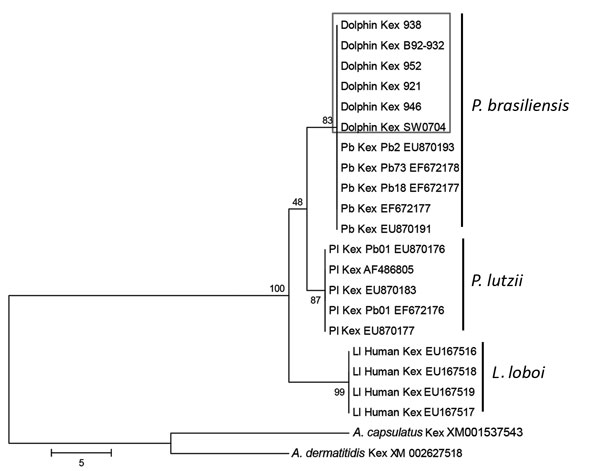Cutaneous Granulomas in Dolphins Caused by Novel Uncultivated Paracoccidioides brasiliensis
Raquel Vilela, Gregory D. Bossart, Judy A. St. Leger, Leslie M. Dalton, John S. Reif, Adam M. Schaefer, Peter J. McCarthy, Patricia A. Fair, and Leonel Mendoza

Author affiliations: Federal University of Minas Gerais, Belo Horizonte, Brazil (R. Vilela); Michigan State University, East Lansing, Michigan, USA (R. Vilela, L. Mendoza); Georgia Aquarium, Atlanta, Georgia, USA (G.D. Bossart); University of Miami Miller School of Medicine, Miami, Florida, USA (G.D. Bossart); SeaWorld, San Diego, California, USA (J.A. St. Leger); SeaWorld, San Antonio, Texas, USA (L.M. Dalton); Colorado State University College of Veterinary Medicine and Biomedical Sciences, Fort Collins, Colorado, USA (J.S. Reif); Florida Atlantic University, Fort Pierce, Florida, USA (A.M. Schaefer, P.J. McCarthy); National Oceanic and Atmospheric Administration, Charleston, South Carolina, USA (P.A. Fair)
Main Article
Figure 3

Figure 3. Unrooted maximum-parsimony phylogenetic tree of partial Kex gene sequences of Paracoccidioides brasiliensis (Pb) from 6 bottlenose dolphins, Indian River Lagoon, Florida, USA, with skin granulomas and homologous sequences of P. brasiliensis, P. lutzii (Pl), and Lacazia loboi (Ll) available in GenBank. Ajellomyces capsulatus and A. dermatitidis homologous sequences were used as outgroups. Strain names or accession numbers are shown. Numbers along branches are bootstrap values for 1,000 resamplings as obtained by parsimony analysis, which support different clusters. Box indicates uncultivated P. brasiliensis from dolphins grouped in the same cluster with cultivated P. brasiliensis from humans with paracoccidioidomycosis. Sequences of P. lutzii and L. loboi were placed with low bootstrap support as the sister group to P. brasiliensis. Scale bar indicates nucleotide substitutions per site.
Main Article
Page created: November 29, 2016
Page updated: November 29, 2016
Page reviewed: November 29, 2016
The conclusions, findings, and opinions expressed by authors contributing to this journal do not necessarily reflect the official position of the U.S. Department of Health and Human Services, the Public Health Service, the Centers for Disease Control and Prevention, or the authors' affiliated institutions. Use of trade names is for identification only and does not imply endorsement by any of the groups named above.
